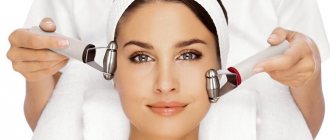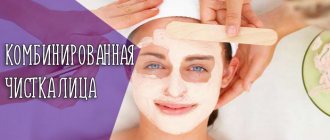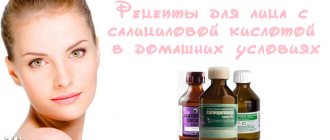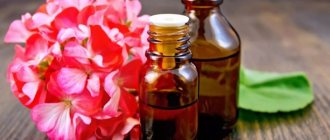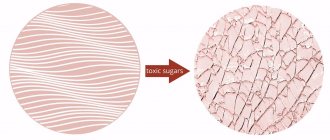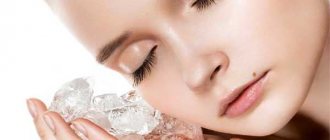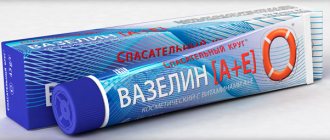Peeling is one of the main procedures aimed at deep cleansing the facial skin. Today there is a huge variety of cosmetic events of this type. One of the most effective and versatile peels is a procedure using glycolic acid. A specific type of light chemical cleansing of the dermis has long established itself as a safe and high-quality method of treating skin diseases. The peculiarity of this peeling is that it can be used for all skin types, and its gentle action has no negative effects even on the most sensitive skin.
What is glycolic acid?
Glycolic acid is an organic compound widely used in the production of creams, scrubs, peels and other cosmetics. It perfectly helps with skin problems: peeling, redness and inflammation. Thus, the compound easily removes age spots and reduces inflammation. Acid can often be found in peelings, creams and tonics. At the same time, they use both the compound in its natural form - obtained from sugar cane, sugar beets or grapes - and synthetically synthesized. The acid has very small molecules that can penetrate deep into the skin, making it extremely effective in eliminating minor wrinkles, removing acne and reducing oiliness.
Glycolic acid has neither color nor odor; it dissolves perfectly in water, which makes it a universal remedy.
Formula and properties of glycolic acid
The formula for glycolic acid is as follows:
HOOCCH2OH
Glycolic acid is a clear liquid. The presence of a yellowish tint indicates that the substance has not been sufficiently purified. Foreign impurities also give color to the liquid. When completely pure, the glycol compound has absolutely no color. The acid belongs to the non-toxic group.
The substance is non-volatile, which makes working with it much easier.
In cosmetology, the size of the molecules of the substance greatly facilitates the work process. They are so small that they easily penetrate the skin. The size of acid particles is influenced by their molecular weight.
In cosmetics, glycolic acid performs the following functions:
- accelerating the regeneration process - thanks to this, damaged areas of the skin return to normal faster;
- cleansing the skin of dead cells;
- removal of sebum and thorough cleaning of pores, their subsequent narrowing;
- stabilization of the functioning of the sweat glands;
- removal and lightening of age spots, getting rid of freckles;
- stimulation of collagen production;
- smoothing of shallow wrinkles.
Obtaining Glycolic Acid
Glycolic acid has gained great popularity in industry: for example, it is used in the food, leather, oil and gas, manufacturing and textile industries. But the compound is most widespread in the production of cosmetics.
In industry, the most commonly used method for obtaining the compound in question is the carbonylation of formaldehyde. The reaction is based on the interaction of carbon monoxide with formaldehyde and water. Strong acids and salts formed on their basis are used as catalysts. The reactions take place at temperatures ranging from 110 to 200 degrees and pressures of the order of 600-700 atm. Acid formation occurs due to the equipment used and the maintenance of the required conditions.
An equally common method for producing glycolic acid is the saponification reaction of a carboxylic acid. The reaction occurs at temperatures ranging from 100 to 160 degrees. Upon completion, the resulting solution is subjected to a filtration procedure.
The industry knows a method for producing glycolic acid by hydrolysis of cyanohydrin. It is obtained by the reaction of formaldehyde with hydrocyanic acid. Compounds based on alkali metals are used as catalysts.
Features of the effects of glycolic acid on the skin
First of all, it is worth noting that glycolic acid is used not only in cosmetology, but also in dermatology. That is, it creates not only a decorative, but also a healing effect.
The compound is considered an extremely strong keratolytic. Keratolytics are substances that help exfoliate dead cells. Dermatologists often prescribe medications that contain glycolic acid for hyperkeratosis and some other skin diseases. Glycolic acid is able to dissolve the components that glue skin scales together, which greatly simplifies the process of exfoliation. After removing dead skin, the openings of the hair follicles are released, making the release of sebum much easier.
Glycolic acid also has the ability to trigger regeneration processes, making the skin more elastic and fresh. At the same time, the substance stimulates the production of collagen, elastin and hyaluronic acid, due to which the condition of the skin improves.
Healthy skin has a natural acidity pH of 4.5-5.5. Regular use of products containing glycolic acid helps maintain this balance. Glycolic acid is especially important in cases where the skin is damaged by detergents, heavy sun exposure, or due to hormonal imbalance.
In addition, glycolic acid has the following effects on the skin:
- prolongation of youth: the compound promotes the production of collagen, making the skin fresher and more elastic;
- cleansing: the compound in question is responsible not only for removing dead cells, but also for removing excess sebum, cleaning enlarged and clogged pores, and starting regeneration processes;
- elimination of wrinkles: the connection triggers a chain of processes responsible for regeneration. It stimulates the formation of new cells and accelerates the production of collagen and hyaluronic acid, helping to get rid of small wrinkles and make deep wrinkles less noticeable;
- treatment of ingrown hairs and keratosis. You may have noticed small “pimples” appearing on the surface of your shoulders, thighs, cheeks and buttocks. The only way to deal with them is to exfoliate your skin regularly.
Rules for home use
In order to experience the magical effect of glycolic acid at home in the safest way, it is best to purchase one of the branded cosmetics that contains it.
Protocol
- Wash and cleanse your face with tonic.
- Degrease your face (you can use alcohol-containing lotion).
- Apply peeling solution for 2 minutes. With each subsequent procedure, the time gradually increases.
- As soon as a strong burning sensation begins, you can point a low-power fan at your face.
- Treat your face with a pre-prepared neutralizing solution (usually included in the peeling complex).
- Place gauze soaked in saline solution on your face to restore the water balance of the skin and relieve hyperemia.
- Apply a soothing mask.
Additional recommendations
- A tandem of two acids gives an excellent effect: glycolic and hyaluronic. So don't be afraid to mix them up.
- The optimal concentration for home peeling is 5-20%.
- Study the instructions for use and do everything in strict accordance with it.
- It is better to do it in autumn or winter, when the sun is not very bright and hot - this will protect against the formation of age spots.
- Number of sessions: for dry and sensitive skin - 3, for normal and combination skin - 5, for oily and problem skin - 10.
- The interval between sessions is 5 days.
- Don't forget to do an allergy test: a day before peeling, apply the solution to your wrist, rinse off after 10 minutes. Monitor your results within 24 hours.
Glycolic acid is very actively used in cosmetology.
Those who have tried this chemical peel know how effectively it exfoliates dead cells and unclogs pores. Considering the air pollution in modern cities and the large number of comedogenic cosmetics, the popularity of this product is not surprising. If you regularly give your skin such general cleaning, it will be blooming and radiant at any time of the year. December 19, 2021
Beneficial properties of glycolic acid
There are 4 main positive properties for human skin:
- exfoliating – the compound helps remove dead scales;
- moisturizing – glycolic acid moisturizes the skin and nourishes it with beneficial substances, which improves the overall condition of the face;
- lightening and correction of relief - the skin is actively renewed: due to its properties, it is used to correct scars, narrow pores and get rid of pigmentation;
- anti-aging effect – glycolic acid makes facial wrinkles less noticeable.
In what cases is the use of glycolic acid recommended?
Acne
Experts recommend using medications containing the compound in question to help combat facial rashes. So, after regular use of peelings, acne goes away much faster, comedones dissolve along with them, the skin becomes smoother, and a beautiful healthy glow appears.
Atrophic scars
With a weekly application of a 70% glycolic acid solution to the skin, the scars first become less noticeable and then disappear completely. The general condition of the face improves significantly.
Melasma
Experiments have shown that the use of glycolic acid-based peels makes the skin color more uniform.
Hyperpigmentation
The 35 percent glycolic peel showed good results. Tests were carried out on patients with post-inflammatory hyperpigmentation: the product used brought a positive result and lightened the damaged areas of the skin.
Photoaging
Cosmetics based on glycolic acid can significantly improve the appearance of the skin and its general condition, reducing the effects of ultraviolet exposure. Glycolic acid helps smooth out fine wrinkles.
Procedures with glycolic acid are allowed after reaching the age of 16. Products based on glycolic acid are most often recommended for those with oily skin - the compound perfectly solves the problem of oily shine and helps tighten pores.
The substance in question is used if there are problems with oily hair.
Glycolic acid also helps get rid of stretch marks on the skin, remove unwanted freckles and help get rid of minor irregularities.
Contraindications to the use of glycolic acid
Despite the many positive properties of glycolic acid, you should be extremely careful with its use in the following cases:
- during pregnancy and lactation;
- in the presence of open wounds on the skin;
- with great inflammation;
- if you are intolerant to the components included in the cosmetic product you purchased;
- if you are allergic to glycolic acid;
- during the recovery period after chemotherapy;
- with herpes;
- for autoimmune diseases: diabetes or lupus;
- in the presence of warts;
- immediately after laser facial resurfacing;
- for any infectious diseases;
- for Negroid and Mongoloid skin types;
- after hair removal;
- for sunburn.
To avoid unpleasant consequences, it is recommended to visit a doctor before starting the procedure and consult with him about the safety of using glycolic acid-based products.
You can start using acid peels once you reach the age of 16. It is recommended to carry out cosmetic procedures in winter, when the exposure to ultraviolet rays on the skin is minimal. Otherwise, glycolic acid can have a negative effect on the condition of the skin and cause its thinning, starting the processes of destruction and aging.
If the use of glycolic acid-based products is urgently needed during periods of high sun activity, it is recommended to apply cosmetics at night: wipe your face with toner and apply a cream that contains acid.
Contraindications for glycolic peeling
Contraindications for this and many other cosmetic procedures include:
- pregnancy and breastfeeding;
- allergy and hypersensitivity of the skin to the components of the drug;
- presence of mechanical damage to the skin in the treatment area;
- the presence of warts or acute inflammatory processes, herpes;
- cancer or previous chemotherapy.
Due to its strong whitening effect, glycolic peeling is suitable only for girls with Caucasian skin type. It is better to carry it out during cold periods of the year so that there are no differences in pigmentation.
Girls with diabetes should be wary of chemical peeling. In this case, it is quite difficult to predict how regeneration will proceed.
What you need to pay attention to
When carrying out procedures with glycolic cosmetics and choosing products based on it, the following nuances must be taken into account:
- concentration – the content of a substance in cosmetic products may vary. Cosmetical tools. Containing no more than 15% acid act more slowly and softly than those containing acid in a concentration of 30 to 70%;
- to have the desired effect, the product must remain on the skin for some time;
- It is recommended to start trying products containing glycolic acid with those that contain it in minimal dosages.
How is glycolic acid used in cosmetology?
Most often, glycolic acid can be found in the following cosmetics:
- in cleansing products and tonics - in them the compound is responsible for maintaining and stimulating regeneration processes;
- in day creams - such products are used for daily care of skin prone to oily sheen and for aging skin;
- in masks - in them the compound in question is combined with cleansing and moisturizing components;
- in scrubs - in such products the combination of acid and mechanical exfoliation is extremely popular - they are combined for better cleansing and renewal;
- in peelings - they include a concentration of glycolic acid that is safe for daily use.
Cleansers based on glycolic acid are recommended to be used once a day before bed - they thoroughly cleanse pores and prevent the formation of rashes, giving the skin radiance. Some types of cleaning products can be used once a week, not more often.
Peels have gained the most popularity in cosmetology. They are used to eliminate deep wrinkles, even out complexion and tighten pores. There are varieties of acid peels for use in salons under the supervision of an experienced cosmetologist and for independent use. In the latter, the acid concentration is lower. Peels based on glycolic acid promote collagen production and have a noticeable lifting effect.
The creams contain minimal glycolic acid. They have a gentle effect and are intended for use at home. Cosmetics belonging to this category soften the skin, nourish it with useful substances and moisturize it.
Peeling with glycolic acid - before and after
Peeling with glycolic acid - before and after
Rating of the best brands
Cosmetics with glycolic acid can be purchased at any store. Moreover, these can be not only peelings, but also creams, masks, emulsions, etc. with a cleansing effect. A rough idea of the range, prices and manufacturers will help you create the following rating:
- Quadro Multi-Application Jet Lotion is a cleansing and exfoliating lotion. GiGi (Israel). $72.38.
- Glico Mask 20 Microcellulaire - tightening mask. Guam (Italy). $64.4.
- Special Glycolic Cleansing Lotion - tonic. Mario Badescu (USA). $59.4.
- Age Control Super-Lift - peeling serum. Holy Land (Israel). $57.3.
- VSH-A glycolic 5% foam - cleansing foam. Mediblock (South Korea). $49.6.
- Isoliss Fluide is an emulsion for combination and normal skin. Uriage (France). $30.
- Normaderm Anti-Age - cream. Vichy (France). $28.5.
- Cleanance Peaux is a mask for deep cleansing. Avene (France). $15.1.
- Cleansing milk. Kosmoteros (Russia). $11.8.
- Peeling gel with willow salicylate. Emansi (Russia). $4.1.
Cosmetics with glycolic acid are often sold in pharmacies, since this drug is actively used in dermatology.
Cosmetics with glycolic acid
If you plan to carry out a full-fledged peeling at home, you will have to purchase a concentrated solution, and the range of these products is also very impressive:
- New Line from Kora (Russia): raspberry (for acne-prone skin), cranberry (anti-aging), lingonberry (for those who suffer from rosacea).
- Medic Control Peel (Russia): Glycolicpeel Whitening (whitening), Keratopeel (for preparation for other types of peeling).
- NEOpeel (Spain): Glycolic (for dry, sensitive and mature skin), Mandelic (with mandelic acid), Wrinkle Off (moisturizes).
- New Peel (Spain): Glycolic Gel-Peel 30, 50, 70%.
- Allura Esthetics (USA): TCA peel (10, 15, 20%), pH 0.5 / 0.6 / 0.7.
- Toskani Cosmetics (Spain).
- Light peeling with chitosan from Medical Collagene 3D (Russia).
- Glicolik 70% from PromoItalia (Italy).
- Exfol: Active - 12% cream exfoliant from Mesopharm Professional (Italy).
- Glycolic 30 profi-peel from Meillume (Canada).
So buying cosmetics with hydroxyacetic acid today is not a problem.
Helpful information. If glycolic acid as a chemical reagent is not suitable for you for some reason, you can always find a more natural alternative. It is found in grapes, cane and sugar beets, and you can always make cleansing peeling masks from them at home.
Peeling with glycolic acid at home
Glycolic peeling is available to everyone outside the salon. The procedure should include the following steps:
- preliminary cleansing;
- applying a cosmetic product;
- neutralization;
- completion of the procedure;
- soothing care.
Before carrying out acid peeling procedures on your own, it is recommended to consult a cosmetologist or carefully study the information about the drug used on the Internet. Before the procedure, it is important to cleanse your face with lotion to remove dirt accumulated during the day and dead particles. If the skin is rough, you should regularly apply a cream with a high content of fruit acids to it 2 weeks before the procedure.
First of all, you need to treat the forehead, then move on to the nose and cheeks and finish the procedure with the chin. The first application should not last longer than 2-3 minutes. The neutralization stage involves treating the face with a special composition. After neutralization, experts recommend washing with a solution of calendula or chamomile to soothe the skin. It is not recommended to use decorative cosmetics for 2-3 days after the procedure, and especially inflamed areas should be treated with emollient creams.
Salon peeling
Like any other salon peeling, glycolic peeling has a number of stages.
Glycolic acid for peeling
- Pre-peeling stage
A week before the event, you should not sunbathe or actively use cosmetics.
- Cleansing
The milk solution is applied to the face to remove surface impurities.
- Application
Glycol gel is applied. A gentle flow of cold air is often provided to reduce the slight tingling sensation.
- Neutralization
An agent is applied to eliminate the effect of the main drug. This saline solution simultaneously performs cleansing, moisturizing and regenerating functions.
- Completion
Special soothing masks and creams with herbal ingredients are applied.
- Rehabilitation
For a week after cleaning, you should not visit saunas, swimming pools, sunbathe or take medications.
The percentage of glycolic acid for various types of peeling by depth of effect:
The cost of salon peeling, depending on the depth of exposure and the drug used, ranges from $8 to $60. Depending on the severity of skin problems, the procedure is recommended to be carried out 3 to 10 times with an interval of 5 to 14 days.
Reviews
Let's look at some reviews about glycolic acid and what effects users noted after use.
Lina, 27 years old
For me, glycolic acid in the fight against pigmentation, acne and wrinkles is a remedy that no other acid can compare with. I do peeling at home and my facial skin looks much better, I don’t know what I would do without this product. I buy glycolic acid on the Internet. If I don’t exfoliate for a long time, my skin’s condition worsens, it becomes oilier and doesn’t look as fresh.
Alena, 34 years old
A cosmetologist recommended peeling with glycolic acid to me. I had the procedure done at her salon. After the procedure, the skin of the face became covered with red spots, which took a long time to disappear - about a week, then crusts appeared on these places. The cosmetologist said that she probably overexposed it, plus this was my skin’s reaction. For the sake of fairness, I note that after the procedure, the anti-aging creams began to be absorbed better and their effect was more noticeable. There are fewer blackheads. However, I no longer want to do peeling with this product; I will use the ones that have been proven for myself - the same mandelic acid. Glycolic acid is clearly not suitable for me.
Tatyana, 42 years old
I consider glycolic peeling the best product that suits my facial skin. Among the minuses, I can note that after the procedure the skin becomes covered with crusts, but this, as for me, is the only minus. Glycolic acid gets rid of blackheads, enlarged pores, oiliness and dead skin layers. The face is fresher and more pleasant, wrinkles are also reduced. I recommend this peeling product.
Benefits and harms
The use of glycolic acid on the face for cosmetic purposes does not always result in high effectiveness. In some cases, procedures involving her can turn out to be harmful. This can happen both during deep peeling in the salon, if the professionalism of the specialist leaves much to be desired, and at home if contraindications and recommended dosages are not observed.
Benefit:
- effective rejuvenation;
- high-quality skin cleaning;
- treatment of dermatological diseases;
- antibacterial effect;
- whitening even pathological hyperpigmentation;
- solution to almost any cosmetic and dermatological problems.
Possible harm:
- dermatitis;
- formation of ulcers;
- hypopigmentation;
- swelling;
- hyperemia;
- atrophy of skin areas;
- exacerbation of diseases caused by staphylococcus;
- single or multiple purulent rashes against the background of acne;
- addiction;
- herpes;
- scar formation.
All of these side effects are quite dangerous and require a separate course of treatment. The reasons for their occurrence can be completely different: failure to comply with contraindications and hygiene rules when performing peeling, exceeding recommended dosages, unprofessionalism or insufficient experience of the cosmetologist who performed the procedure, individual skin reactions.
Did you know that... the main source of glycolic acid production for the beauty industry is sugar cane?


